QuestionQUESTION: Hi,I have a quick question,my leo has shed but cant seem to get the shed off her face,it is loose and im trying to grab it off her to help her get it off (she can barely see cause its covering her eyes),is there any tips you can offer me to help her get the shed off.
Also my leo used to eat crickets all the time then stopped and started eating mealworms,now she wont eat the meal worms,I have to force feed her with baby food,this has been going on for a few months now,when she first started doing this I fed her baby food for a week then tried mealworms and she ate 10 then trying to feed her a few days after she wouldn't eat again and now since then I can only force her to eat baby food,Do you have any tips to have her eating insects again. This has been going on a few months so I dont think she is in any danger. Thank you for all your help.
ANSWER: Hi Taylor,
I would take her out of her tank and mist her gently with some warm water. That should help loosen it. Also, be sure that you are providing a proper humid hide for her in her tank. I'm going to include a basic care sheet that I wrote to help people out. In it I give some ideas on how to make a humid hide...
There are other insects to try...some suggestions are in the care sheet.. One other trick to try is to break the hind legs off the crickets..that way they can't jump and may spark her interest.
Double check your temperatures and care areas..many times not eating is due to a simple adjustment needed in temperatures.
Try letting her go for a few days without offering food(making sure your temps, etc are correct). She may decide that the insects look pretty good!! Try some superworms or wax worms..maybe just a change in the insect offered will help. It also helps and is best for them to offer them a variety of insects on a regular basis.
BASIC CARE FOR A LEOPARD GECKO
Leopards are pretty easy to care for but they do need
special care. Here are some of the basic needs of your gecko.
HOUSING: The need to have at least a 20 gallon long tank for one Leo. This needs to have a secure fitting screen top...they can be quite the escape artists!!! They need to have a humid hide box.You can make this with something as simple as a small plastic dish with a hole cut in one side and a small mesh bag filled with some Sphagnum moss coconut bark or Peat moss that you mist.
I made mine out of the small plastic folgers coffee containers...I cut an opening in the lid..and put the moss in..they LOVE it. I use the terrarium moss in mine.
I use that on the warm side of the tank. Be sure to provide a cool hidebox on the other end. I also provide a mid temperature hide...which is in the middle of the tank.I use the critter caves which you can purchase. NOT the ones that have heat in them!!!!
Provide secure climbing areas for your gecko. Fake plants, rocks and branches are all fine to use. be sure there are no wires or sharp ends to any fake plants you use.
*****SUBSTRATE:(that's the stuff on the floor of your tank) Newspaper, lizard carpet or paper towels work great and are easy to clean and are much safer than any loose substrate. Sand or other loose substrate is not recommended as that they can be deadly to the leo when it is ingested(eaten, even by accident while eating their insects)...A very graphic site of an impacted leo surg can be seen at http://homepage.mac.com/exoticdvm/reptile/PhotoAlbum181.html it is very graphic!!! ******What I have found that works great for safety and heat distribution is using about 1/4 inch of childrens play sand(since the tiles fit tight together, there is no sand danger) on the bottom of the tank and on top that you place ceramic or slate floor tile. What is nice is that the 12 x 12 squares fit perfect in a 20 gallon tank with no spaces between the tiles. The sand and the tile distribute the heat wonderfully. Using the under tank heater as described is what distributes the heat. Also, overhead heat will help in heating the tiles...I've been using this set up for several years and the leos love it. Using a tile that isn't smooth is recommended. **********
TEMPERATURES: They need a warm area ( on the floor) of 88-92 degrees and a
cooler area in the upper 70s, low 80s. At night their temperature can drop to the low to mid 70's.
Never use a hot rock for a leopard gecko...or any reptile.
They can severely burn any reptile. You can use a heating
pad under the tank,under tank heater for the warm area. You can use a regular household lightbulb in a dome fixture with a ceramic socket in it to keep the warm area at the 88-92 degree area if needed there, otherwise, placing the lightbulb about midway in the tank will give the needed temeratures throughout the tank. You may have to play with the wattage of the bulb but generally 40-60 watts is sufficient.At night, no white light. If room temperatures stay above 70 degrees, no extra night heat is needed. The undertank heater or heating pad should cover about 1/3 of the tank....be sure to raise the tank up about 1/4-1/2 inch off the stand when using an undertank heat source to prevent heat build up which can cause the glass to break and hot spots in the glass. Be sure to have a good layer of newspaper, carpeting or, even a thin flat rock(such as tile) on top the area that the undertank heat source is placed...if you use a thin rock or tile, it helps to distribute the heat very well.
You can use the special nighttime lights that are designed for reptiles. I like using a ceramic heat emitter on a thermostat for nighttime heat.
DO NOT use black lights or party lights as they can cause eye damage!!!!
The wattage you use will vary based on room temperature and size of tank.
LIGHTING: Leopard geckos do not need UVB lighting but it does not hurt them to give them uvb. They should have some type of light during the day, be it a uvb tube, regular florescent light, reptile day light or regular household lightbulb. NO white lights at night!!!
FEEDING: Geckos should not be fed crickets or other insects that are bigger than the space between their eyes. Generally, hatchlings can be fed more than once a day,juvys can be fed twice a day, adults are fed once daily or every other day, in the early evening. Crickets and other food items such as silk worms, super, and an occasional treat of a wax worm, need to be dusted with a calcium supplement two times a week and also they should have a small dish of calcium in their tank. I use the lid of a milk jug for the little dish of calcium in their tank. For dusting the insects, Use a calcium with no added phosphorus. Insects must be gut loaded(fed) for at least 48 hours prior to feeding your gecko. Remove any uneaten crix or superworms after 15-20 minutes..... Place a piece of cut potato in the tank so that if you have missed any uneaten insects, they will eat the potato instead of nibbling on your gecko!!!
*************You have to be sure to feed your crickets and insects the right foods before feeding them to your gecko. If your crickets/insects are not healthy and well fed, your gecko will not get the nutrition he needs. You can gut load your crickets and insects greens, veggies, cereals or specially designed commercial foods for crickets or the insects you are feeding. ************
Be sure to have a small dish of clean water for your gecko at all times!!
You can offer them some baby food or fruits on occasion ...
Mine will even eat a small piece of watermelon now and then.WATER: always provide a dish of drinking water. If you choose to mist your gecko to drink, its best to not get the tank too wet as that they do not do well with higher humidity. Sometimes its better to take your leo out of their tank to mist them to get them to drink!!!
HANDLING: Some geckos enjoy being held...others prefer not to be handled at all. Be sure to be very gentle when holding your leo and NEVER grab them by the tail! Their tails are extremely fragile and will break.
I do suggest finding a vet that can treat reptiles BEFORE you actually need one!!! To find a vet that is able to care for reptiles:
http://www.herpvetconnection.com
http://www.arav.org/ECOMARAV/timssnet/amm/tnt_mdsearch.cfm
http://www.anapsid.org/vets/
For more information on leopard geckos:
http://www.drgecko.com
If you have any questions or don't understand something, please let me know.
---------- FOLLOW-UP ----------
QUESTION: Thanks for your input,She was able to get the shed off but now there is shed the is covering one eye and I have tried using warm water and q-tip to loosen it up,it is like rock solid,I also bought some shedding solution and that has no worked either Im afraid to pull the shed off the eye because im afraid ill hurt her,her eyes are closed so its not on her eye itself more like her eye lid,her other eye looks like there is shed in between the eye lids and she hasn't been able to open that one either. Please help
ANSWER: Hi Taylor,
Glad she got some of it off..you are correct in not pulling off the remaining shed..You can try using some sterile saline solution(warmed slightly) and gently mist the eye with that to see if that helps. If it doesn't, they you will need to call a vet to see if they would be willing to suggest some type of eye ointment that you can use. Some times they will recommend human eye ointments or drops that can provide both aide in the shedding and also be an antibiotic ointment for the eye to prevent/cure an infection. Some ointments that a vet may recommend are:
Neomycin or Gentamicin Sulfate Ophthalmic Solution... the first is an ointment, the 2nd are drops. Hopefully the humid hide and misting carefully with the sterile saline will help loosen it. Don't wait too long to see if that works before contacting a vet as it can easily turn into an infecction.
---------- FOLLOW-UP ----------
QUESTION: Ok I'm going to keep trying that. I read on a website that if I can't get it off that it will just come off when she sheds next. Is this true? I'll be sure to do what you recommend. Thanks again
AnswerHi Taylor,
It may come off with the next shed. It can depend on how thick the shed is..has it built up from a few bad sheds..or is it just from teh last shed.. Do be sure to keep her humid hide on the warm side and moist!! If its not bothering her, and her eye doesn't look red, swollen or oozing, then waiting is most likely ok, while doing the rinses that is. BUT!!! If you see her pawing at it, the eye changes in any way...then a vet is needed to prevent damage.

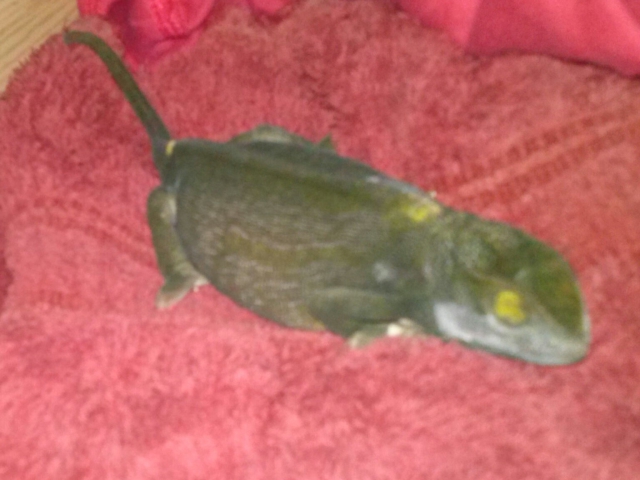 Flap neck Chameleon. Urgent help PLEASE!
QuestionPaula about 8 hrs afte
Paula straight af
Flap neck Chameleon. Urgent help PLEASE!
QuestionPaula about 8 hrs afte
Paula straight af
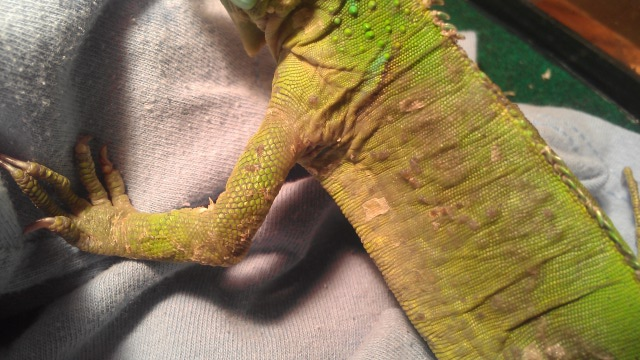 Black and red blisters/bumps on my iguana
Question
black bumps under his belly
hello
Black and red blisters/bumps on my iguana
Question
black bumps under his belly
hello
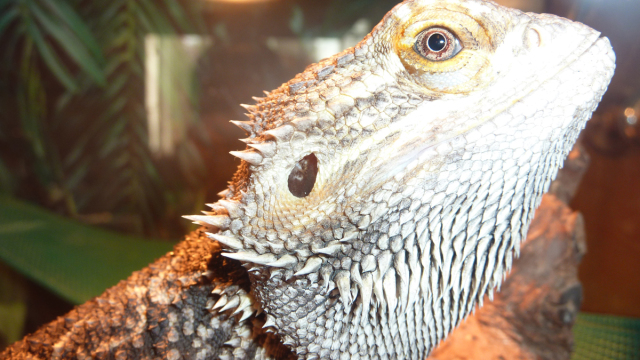 Bearded Dragon Ear Color
QuestionQUESTION: Hello, I just got my bearded dragon a
Bearded Dragon Ear Color
QuestionQUESTION: Hello, I just got my bearded dragon a
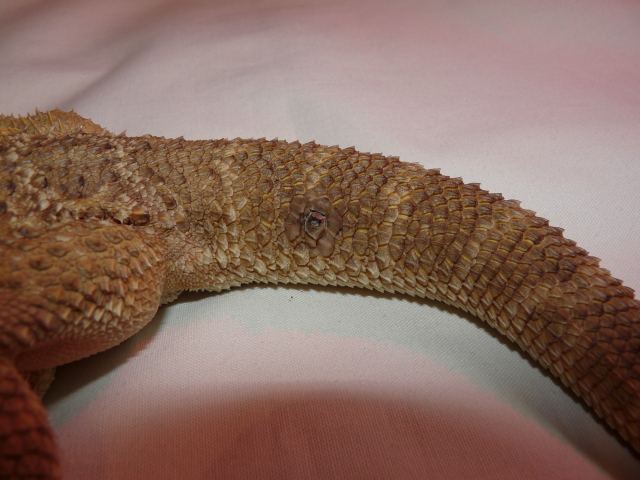 Strange scales on tail
Question
Lumpy scales
Hi, I have attached an image of m
Strange scales on tail
Question
Lumpy scales
Hi, I have attached an image of m
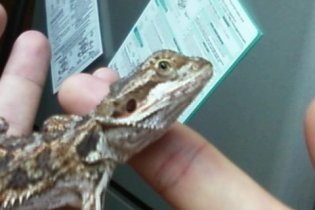 Lower jaw color
QuestionQUESTION: Hi again. I have yet another question
Lower jaw color
QuestionQUESTION: Hi again. I have yet another question